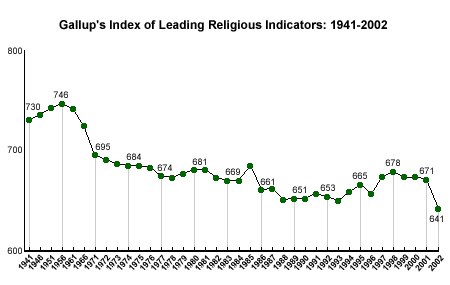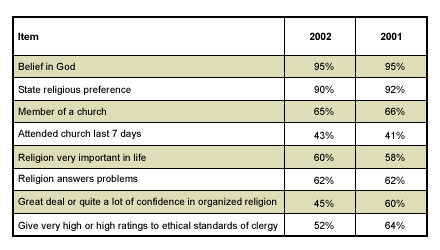Undoubtedly reflecting the 2002 Catholic sexual abuse scandals and the decline in positive attitudes of Catholics toward their church and clergy, the latest Gallup Index of Leading Religious Indicators shows the overall rating for organized religion in 2002 plunging to its lowest level in more than six decades.

Since 1940, Gallup has maintained an Index that provides broad annual assessment of religiosity among Americans, based on eight measurements dealing with religious beliefs and practices. A "perfect score" would be 1,000. The latest figure, for the year 2002, stands at 641 -- a 30-point drop from the 2001 figure of 671.
The Gallup Index of Leading Religious Indicators hit its highest point in 1956 at 746. That peak was followed by a gradual downward trend that lasted until 1989, when the figure bottomed out at 651. In the 1990s, the trend climbed slowly, to 678 in 1998.
The specific findings for 2002, compared with those from 2001, are presented in the table below.

The Impact of the Catholic Sexual Abuse Scandal
The two specific items driving the Index's drop clearly speak to the impact of the sex abuse scandal plaguing the Catholic Church. In 2002, 52% of Americans gave very high or high ratings to ethical standards of clergy versus the 64% who did so in 2001. Americans' confidence in organized religion declined significantly as well; 45% of Americans had "a great deal" or "quite a lot" of confidence in organized religion in 2002, versus 60% in 2001.
These figures reflect the findings of a June 2002 Gallup survey, in which approximately 45% of American adults have a "great deal" or "quite a lot" of confidence in organized religion. A wide gap separated the responses of Protestants and Catholics, with 59% of Protestants having "a great deal" or quite a lot" of confidence in organized religion, compared to only 42% of Catholics who shared this sentiment. (See "Americans' Confidence in Military, Presidency Up; Big Business, Organized Religion Drop" in Related Items.)
About the Index
The Gallup Index of Leading Religious Indicators combines religion factors that have been remarkably constant over the years with those than can quickly change and react to events in both the religious and secular worlds.
The Constants:
Belief in God
Religious preference
Membership in faith communities
Worship attendance
Important of religion
The Variables:
Ability of religion to answer today's problems
Confidence in the church
Confidence in the clergy
The 2002 Index was compiled from surveys of national adults, aged 18 and older, conducted throughout the year.
